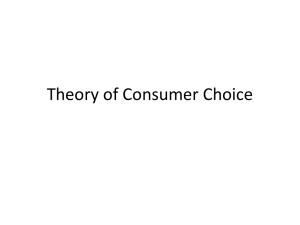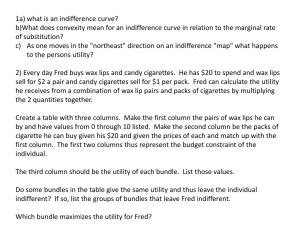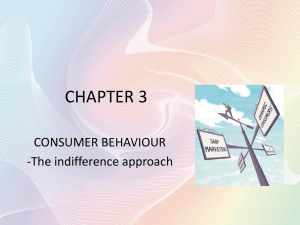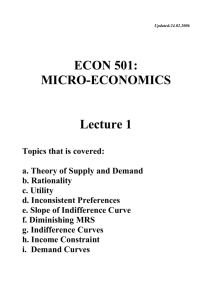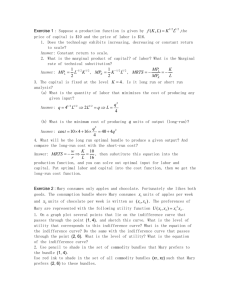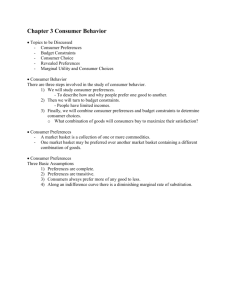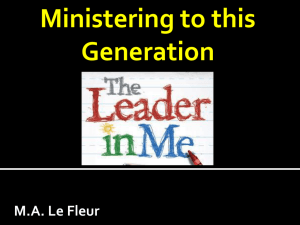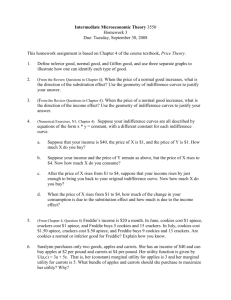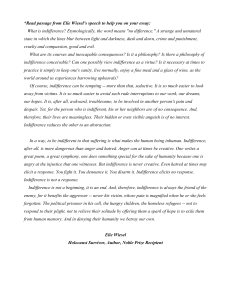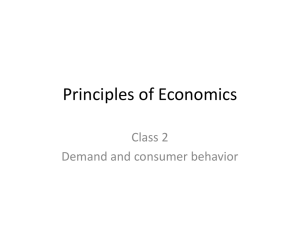File
advertisement
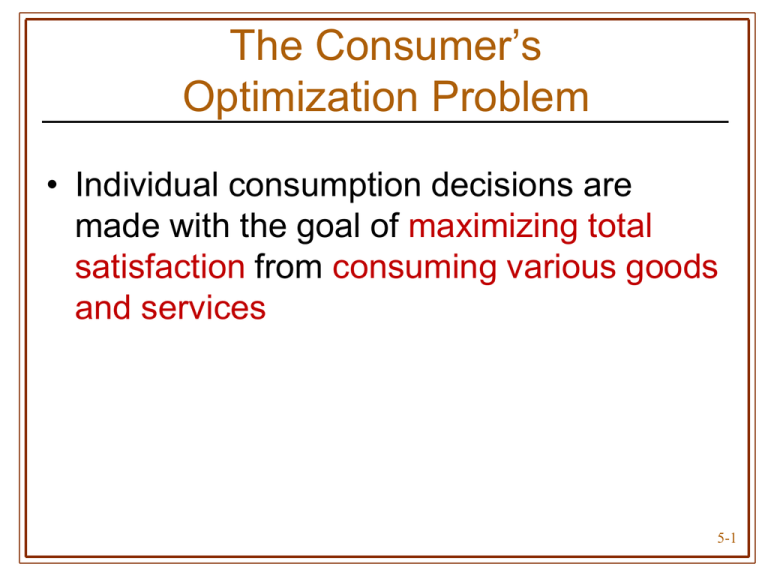
The Consumer’s Optimization Problem • Individual consumption decisions are made with the goal of maximizing total satisfaction from consuming various goods and services 5-1 Consumer Theory • Assumes buyers are completely informed about: • • • • Range of products available Prices of all products Capacity of products to satisfy Their income 5-2 Indifference Curves • Locus of points representing different bundles of goods, each of which yields the same level of total utility • Negatively sloped & convex 5-3 Properties of Consumer Preferences • Completeness • For every pair of consumption bundles, A and B, the consumer can say one of the following: • A is preferred to B • B is preferred to A • The consumer is indifferent between A and B 5-4 Properties of Consumer Preferences • Transitivity • If X is preferred to Y, and Y is preferred to Z, then X must be preferred to Z 5-5 Properties of Consumer Preferences • Nonsatiation • More of a good is always preferred to less 5-6 Utility • The benefits consumers obtain from the goods and services they consume is called utility. • A utility function shows an individual’s perception of the utility level attained from consuming each conceivable bundle of goods 5-7 Marginal Utility • Addition to total utility attributable to the addition of one unit of a good to the current rate of consumption, holding constant the amounts of all other goods consumed MU U X • MU= Changes in Total Utility / Change in No of Units Consumed 5-8 Constrained Utility Maximization (Figure 5.8) 50 Quantity of pizzas 45 •A 40 •B •D • E R 30 IV III 20 • C 15 10 0 10 20 30 40 50 60 70 II T I 80 90 100 Quantity of burgers 5-9 Marginal Rate of Substitution • MRS shows the rate at which one good can be substituted for another while keeping utility constant • Negative of the slope of the indifference curve • Diminishes along the indifference curve as X increases & Y decreases • Ratio of the marginal utilities of the goods Y MU X MRS X MUY 5-10 How to get MRS Formula • U = ƒ(XY) by differentiation, dU= ƒ1dX + ƒ2dY (Here, U= Utility; X,Y= 2 goods) ƒ1= ΔU/ ΔX = MUx ƒ2= ΔU/ ΔY = MUy as per indifference curve, U remains constant. So, U = 0 → ƒ1dX + ƒ2dY = 0 → ƒ1dX = - ƒ2dY → ƒ1 / ƒ2 = - dX/dY as indifference curve is neutral, so…. IdX/dYI = I ƒ1 / ƒ2 I = MUx/ MUy So, MRSxy = MUx/ MUy Here, 5-11 Slope of an Indifference Curve & the MRS (Figure 5.3) Quantity of good Y 600 A T C (360,320) 320 I T’ B 0 360 800 Quantity of good X 5-12 MRS = slope of indifference curve = slope of tangent line 5-13 The slope is 35/35 = 1 5-14 MRS = − ΔY /ΔX = 5 /10 = 1 2 5 10 5-15 Before, − ΔY /ΔX = 5/10 or 1/ 2, After, − ΔX/ ΔY = 10/5 or 2 10:5 or 2:1 5 10 5-16 5-17 Consumer’s Budget Line • Shows all possible commodity bundles that can be purchased at given prices with a fixed money income M PX X PYY or M PX Y X PY PY 5-18 Consumer’s Budget Constraint (Figure 5.5) 5-19 Typical Budget Line Quantity of Y M PY (Figure 5.6) •A Y M PX X PY PY B •M Quantity of X PX 5-20 Shifting Budget Lines (Figure 5.7) 100 80 R A Quantity of Y Quantity of Y 120 F 100 A B N C B D 160 200 240 125 200 250 Z Quantity of X Quantity of X Panel A – Changes in money income Panel B – Changes in price of X 5-21 The following figure shows a portion of a consumer’s indifference map. The consumer faces the budget line ZL, and the price of Y is $20. 600 The consumer's income = $__________. The price of X is $_____________. 20 5-22 The following figure shows a portion of a consumer’s indifference map. The consumer faces the budget line ZL, and the price of Y is $20. The equation for the budget line ZL is Y = ______________________. 30 - 1x 30/ 30 5-23 The following figure shows a portion of a consumer’s indifference map. The consumer faces the budget line ZL, and the price of Y is $20. What combination of X and Y would the consumer choose? Why? 15X and 15Y 5-24 The following figure shows a portion of a consumer’s indifference map. The consumer faces the budget line ZL, and the price of Y is $20. The marginal rate of substitution at the combination in part c is __________. MRS=Px / PY = 20 / 20 =1 5-25 The following figure shows a portion of a consumer’s indifference map. The consumer faces the budget line ZL, and the price of Y is $20. If the budget line pivots to ZM, the 10 consumer chooses _______ units of 15 good X and _________ units of good Y. 5-26 The following figure shows a portion of a consumer’s indifference map. The consumer faces the budget line ZL, and the price of Y is $20. Along budget line ZM, the price of X is 20 $_________ and the price of Y is $________. 30 5-27 The following figure shows a portion of a consumer’s indifference map. The consumer faces the budget line ZL, and the price of Y is $20. MRS= 30/ 20 =1 The new MRS is equal to __________. 5-28 The figure below shows a portion of a consumer’s indifference map, and a budget line. The consumer’s income is $1,200 and the price of Y is $6. Using the given budget line, what is one point on the consumer’s demand for X? (Both Price & Quantity) Px = $1,200/200 = $6 and X = 100 5-29 The figure below shows a portion of a consumer’s indifference map, and a budget line. The consumer’s income is $1,200 and the price of Y is $6. Pivot the budget line and derive two other points on the consumer’s demand for X. At A, Px = $1,200/100 = $12 and X = 50 At B, Px = $1,200/200 = $6 and X = 100 At C, Px = $1,200/300 = $4 and X = 150 5-30 Market Demand • Market demand is a list of prices and the quantities consumers are willing and able • to purchase at each price in the list, other things being held constant. • Marketdemand is derived by horizontally summing the demand curves for all the individuals in the market. 5-31 Derivation of Market Demand Quantity demanded Price Consumer 1 Consumer 2 Consumer 3 Market demand $6 3 0 0 3 5 5 1 0 6 4 8 3 1 12 3 10 5 4 19 2 12 7 6 25 1 13 10 8 31 5-32 Derivation of Market Demand Figure (5.10) 5-33

